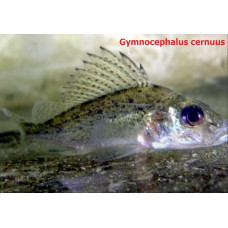Ruffs (Gymnocephalus) are a genus of river and lake fish of the perch family. Freshwater bottom-dwelling fish 10-25 cm long. The dorsal fin is one. The mouth is small, inferior, retractable. On both jaws are bristle-shaped teeth. There are few or no teeth on the caterpillar and palatine bones. The body is compressed from the sides. The head has no scales. Cephalic bone ends with a spike. Inhabit reservoirs of central and northern Europe, basins of southern seas, and northern parts of Asia. 3 species. Gymnocephalus cernuus and Gymnocephalus acerinus are the most widely distributed. Freshwater fish. Feed on benthic invertebrates, fish eggs and larvae. Gymnocephalus are fished in many water bodies of the country. A favorite object of recreational fishing.
The ruff is a very unpretentious, usually gregarious species and does very well in a wide range of environmental conditions. It can be found in both freshwater and brackish-water bodies of water with salinity values up to 10-12 ppm; in lake and flow-through systems; at depths from 0.25 to 85 meters; at sea level and in mountainous habitats and from oligotrophic to eutrophic waters; the critical water temperatures for ruff are 0-2°C and 34.5 °C. Despite this wide range of acceptable conditions, three main features of habitats for this species can be distinguished. The ideal conditions for this fish are quiet ponds with soft bottoms not covered by aquatic vegetation; usually the population density of the ruff is increasing with the eutrophication index. Soft-bottom areas are more attractive to ruff, given that the majority of food items are found in these areas, and because these areas are usually associated with relatively deep and shaded parts of the pond - since all ruff species have physiological adaptations that help them adapt to living in low light conditions.
The ruff usually reaches sexual maturity at the age of 2-3 years, with a body size of about 11-12 centimeters; in some water bodies ruff may start reproducing even at the age of one year, which researchers explain by the tide of mostly warm water or high mortality in the early stages of life in this population. This species lays eggs on a very wide range of substrates at depths of 3 meters or less, while not protecting them. Spawning occurs from mid-April to June, in a fairly wide temperature range - there are known cases of spawning at both 6 ° C and 18 ° C. The range of pH, at which the ruff roe can normally develop, is one of the largest among fish for which this parameter is known, and lies between 6.5 and 10.5. The ruff may lay 2-3 clutches of eggs during one act of spawning; the number of eggs depends on the size of females and contains from 10 to 200 thousand pieces. The diameter of the eggs also depends on the size of the female and varies between 0.34-1.3 mm, with the eggs of the first clutch always being larger and more yellowish than those of the second and third clutches. Development of eggs lasts 5-12 days at temperatures from 10 to 15°C. In some populations, hermaphroditism has been recorded in the ruffe.
In most cases, researchers determine the age of the ruffe by the number of growths on the scales; the number of orbs in the otoliths is also sometimes used as an indicator of age. Female ruffs can live to a maximum of 11 years, and males generally do not survive seven years; however, in natural populations, up to 93% of fish are between 1 and 3 years old.
Early in their lives, young ruffs feed mainly on rotifers and copepod larvae; for ruffs over 1 cm long, cyclops, chironomid larvae, and branch-eating crustaceans become the main food resource. The most consumed genera of chironomids are Chironomus (especially Chironomus plumosus) and Procladius. Over time, as they grow, the proportion of chironomids in the diet of the ruffe decreases. The main food resource of the adult ruff is a variety of (mostly benthic) worms, small crustaceans and leeches. Ruffs caught in saltwater reservoirs or at greater depths (30 m or more) were also active consumers of macroscopic crustaceans, such as Pallasea quadrispinosa, Pontoporeia affinis, Mysis relicta, Neomysis integer, Diaporeia affinis and Gammarus spp. The ruffs actively feed throughout the year, although in late autumn and winter they do not feed as much as in summer. The main sensory organ used by the ruffe when searching for prey is the lateral line. Even a blinded ruff is able to find immovable prey solely due to this sense organ. Nevertheless, when feeding during the light part of the day, the ruffe also actively uses its vision.
Natural enemies of the ruff, which can eat a large number of individuals, are pike, pikeperch, large perch; also in small numbers ruff are destroyed by burbot, eel, catfish and salmon. Occasional cases of cannibalism have been observed.
Gymnocephalus
Tags: gymnocephalus


